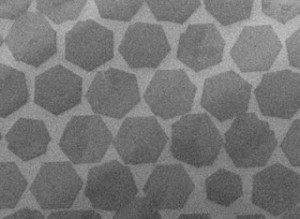Carbon-based graphene was the topic around water coolers in materials science departments in the month of March as researchers at Hong Kong Polytechnic University claimed to have invented a graphene-based battery running solely on ambient heat. If the results can be duplicated by other laboratories then these researchers may have found a new technology for self-charging portable devices.
What is graphene? Discovered in 2004, graphene is a carbon-based material made from atoms bound together by double-electron bonds. It forms in thin films one atom in thickness. The picture below shows individual graphene crystals.

Graphene based ultrafast transistors would replace silicon-based technology. Graphene is seen as a potential high performance material replacing carbon fiber in avionics and aerospace construction.
In the Hong Kong study researchers did control tests on their graphene-based battery to ensure that the sustained energy output from the device was not coming from a chemical reaction. The jury remains out on this claim but if it is proven to be a workable technology then we may have a new power source for artificial organs that would be sustained by the heat generated within a body, or electronic devices that would continuously generate energy through interaction with a warm environment.
We’ll keep our eye on this one and let you know what the research community discovers when they attempt to duplicate these experimental results.








In Italy a new startup develop a solid state Graphene-Quarz flexible cell harvesting energy from browian motion. First prototypes have been developed in 2012, now technology seems ready for mass production.
http://www.gqenergy.it/
Is there independent verification of what is claimed on the GQenergy website?
Well, i am “no one” so my test of the prototype could not be defined an independente verification… i remember they show such prototypes to some research group, but at the end no test results have been published
Hi Enrico, It would be good to know the funding behind GQEnergy. That will tell us more about its viability as a technology for the mass market as anything else.